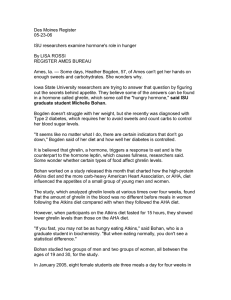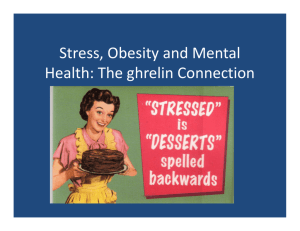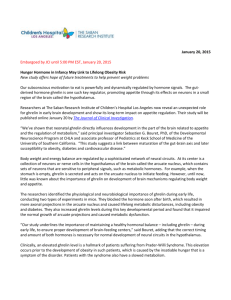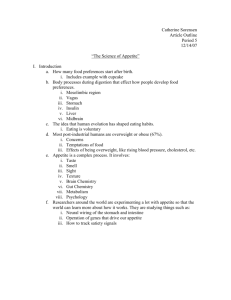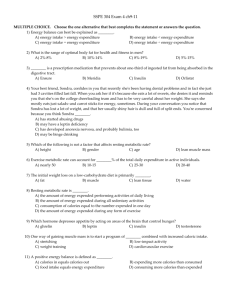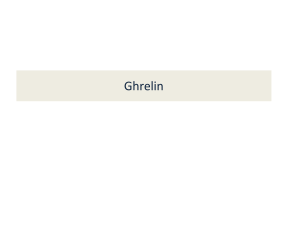The Common Voice, SC 05-17-06 Study: Ghrelin Levels About Calories, Not Carbs
advertisement
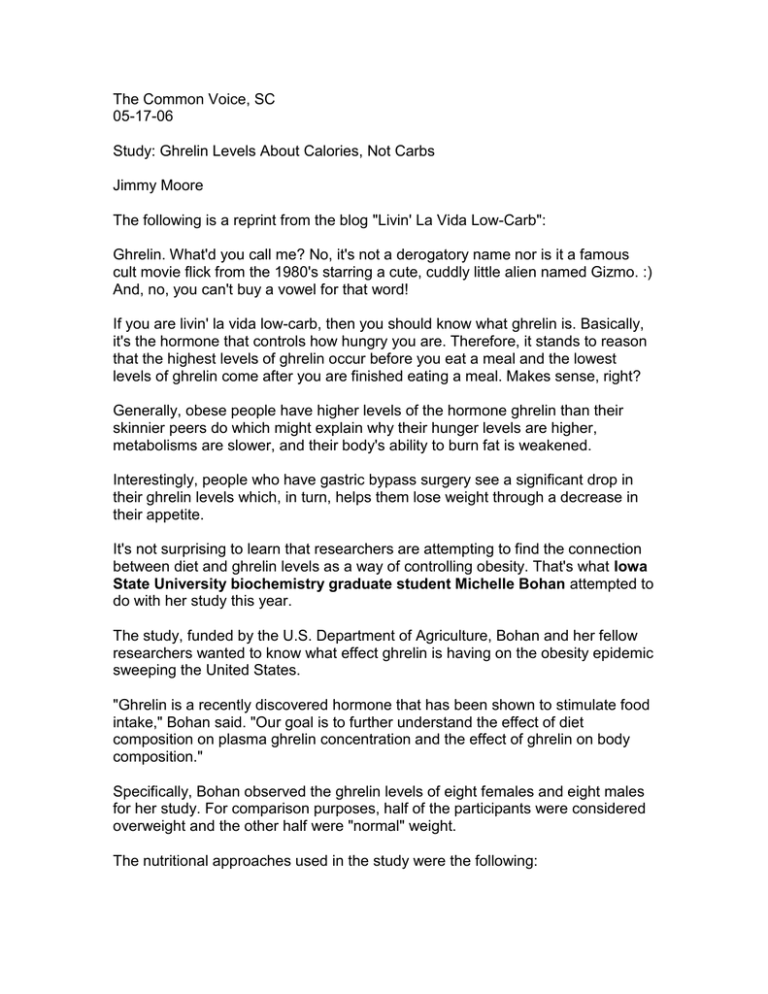
The Common Voice, SC 05-17-06 Study: Ghrelin Levels About Calories, Not Carbs Jimmy Moore The following is a reprint from the blog "Livin' La Vida Low-Carb": Ghrelin. What'd you call me? No, it's not a derogatory name nor is it a famous cult movie flick from the 1980's starring a cute, cuddly little alien named Gizmo. :) And, no, you can't buy a vowel for that word! If you are livin' la vida low-carb, then you should know what ghrelin is. Basically, it's the hormone that controls how hungry you are. Therefore, it stands to reason that the highest levels of ghrelin occur before you eat a meal and the lowest levels of ghrelin come after you are finished eating a meal. Makes sense, right? Generally, obese people have higher levels of the hormone ghrelin than their skinnier peers do which might explain why their hunger levels are higher, metabolisms are slower, and their body's ability to burn fat is weakened. Interestingly, people who have gastric bypass surgery see a significant drop in their ghrelin levels which, in turn, helps them lose weight through a decrease in their appetite. It's not surprising to learn that researchers are attempting to find the connection between diet and ghrelin levels as a way of controlling obesity. That's what Iowa State University biochemistry graduate student Michelle Bohan attempted to do with her study this year. The study, funded by the U.S. Department of Agriculture, Bohan and her fellow researchers wanted to know what effect ghrelin is having on the obesity epidemic sweeping the United States. "Ghrelin is a recently discovered hormone that has been shown to stimulate food intake," Bohan said. "Our goal is to further understand the effect of diet composition on plasma ghrelin concentration and the effect of ghrelin on body composition." Specifically, Bohan observed the ghrelin levels of eight females and eight males for her study. For comparison purposes, half of the participants were considered overweight and the other half were "normal" weight. The nutritional approaches used in the study were the following: 1. Atkins diet (10/45/45 ratio of carbohydrates/protein/fat) 2. SAD (AHA) diet (63/12/25 ratio of carbohydrates/protein/fat) "Some people may need to modify their diet -- add a little bit more protein, maybe decrease the amount of carbohydrates to achieve (maximum) health," Bohan said. Study participants ate three meals per day for four weeks in a controlled eating environment, with two overweight and two normal weight participants beginning on the Atkins diet while two overweight and two normal weight participants went on the AHA diet for a period of two weeks and then they switched diets. Blood samples were tested on days 6 and 20 from each student one hour before and one hour after their lunch. Additionally, on days 13 and 27, blood samples were tested every hour from 7:00am until 9:00pm. On the last day of each two week phase of the respective diets, the study participants were asked to fast from 7:00am until 12:00pm before they could eat their lunch. On these days, blood was test at 11:00am and then again one hour after they ate lunch. Bohan noticed that the blood samples indicated that ghrelin concentrations were different according to diet, body weight, the time of the day, and other variables. She noted that the women who were on the Atkins diet experienced LOWER LEVELS of fasting ghrelin than the women on the AHA diet did. But on the days that the study participants did not fast, ghrelin levels in both groups one hour before lunch were almost identical. These results were presented at a scientific meeting in San Francisco last month and the results from the male participants is still forthcoming. After reviewing the results of her data from the women in the study, Bohan states that diet did not seem to play a significant role in ghrelin concentrations in either the overweight or normal-sized participants. "So, this study supports the hypothesis that ghrelin is controlled by caloric content, rather than the concentrations of proteins, carbohydrates and fats in the diet." Bohan added that she is trying to exhaust every possible solution to the obesity problem without having to resort to risky and and potentially dangerous options that are too readily recommended these days. "If you could control things through your diet, would you try that first before taking more extreme measures (like) surgery (or) by taking shots every day?" she asked. You have to admire that a graduate researcher cares enough to ask a question like that. In this day and age when doctors are writing prescriptions for everything under the sun and giving the quick green light to things like gastric bypass surgery, it is refreshing to see someone like Bohan at least attempt to find a way around this template. By the way, this version of the Atkins diet they used for this study is probably closer to the ketogenic diet than what Dr. Robert C. Atkins recommended in his books. The 10/45/45 ratio seems a bit short on the carbs for most people following the actual Atkins diet plan. In reality, it should probably be closer to 25/30/35 or even 30/40/30 depending on which phase of Atkins you are in. I'd be interested in knowing what the ghrelin levels would look like using this macronutrient ratio instead. While Bohan concludes that calories are what ultimately determines the ghrelin concentrations in the body, I still think there is merit to restricting carbs while boosting protein and fat. It will be very interesting to see if there are different results with the men who went through this study earlier this year. We'll be looking for that data in a few months from now. You can e-mail Michelle Bohan about her study at mbohan@iastate.edu. 5-17-06 UPDATE: Actually, after I got to thinking about the subject of ghrelin while I was sleeping last night, I remembered this was discussed at the low-carb conference I attended in Brooklyn, New York in January. And there WAS a study done comparing a 30/40/30 diet with the more high-protein, carb-restricted (CHO) 10/60/30 diet. Margriet S. Westerterp-Plantenga and Manuela P.G.M. Lejeune from Maastricht University in The Netherlands conducted a study assessing satiety factors between the two dietary approaches. One of the factors they measured was the hormone ghrelin. They observed 12 female subjects who were "normal" weight and one of the things they wanted to see is if the different diets produced different levels of ghrelin. Satiety was "significantly higher" in the 30/40/30 group and, therefore, hunger was "significantly lower." But what about the ghrelin levels? They were "not different between diets." Hmmmm, wouldn't you think there would be SOME difference in ghrelin levels by changing the macronutrients around? But at least the study showed that PROTEIN plays a much bigger role in our appetite than we have been told by the health "experts." Oh yeah, we can't be having everybody eating meat because that would just be "unhealthy" now, wouldn't it?! WAKE UP to the truth people! There's a lot more to protein consumption than our health "experts" and media are telling us. You can e-mail Margriet S. Westerterp-Plantenga about her study at M.Westerterp@HB.unimaas.nl.
